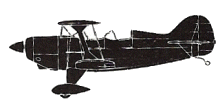
ASN Wikibase Occurrence # 45413
This information is added by users of ASN. Neither ASN nor the Flight Safety Foundation are responsible for the completeness or correctness of this information.
If you feel this information is incomplete or incorrect, you can submit corrected information.
| Date: | Wednesday 25 September 2002 |
| Time: | 17:08 |
| Type: |  Aviat S-2C |
| Owner/operator: | Fly Aerobatic |
| Registration: | N116PS |
| MSN: | 6020 |
| Total airframe hrs: | 49 hours |
| Fatalities: | Fatalities: 2 / Occupants: 2 |
| Aircraft damage: | Destroyed |
| Category: | Accident |
| Location: | Sheridan, IN -
 United States of America United States of America
|
| Phase: | Manoeuvring (airshow, firefighting, ag.ops.) |
| Nature: | Training |
| Departure airport: | Indianapolis, IN (TYQ) |
| Investigating agency: | NTSB |
| Confidence Rating: |
The Aviat Pitts S-2C was seen performing a tail slide when it fell backwards and entered an inverted spin from an altitude of about 2,500 feet above ground level. A witness stated that the airplane had been making smoke during aerobatics, but not during the tail slide. The airplane climbed to about 2,000 feet (AGL) and fell over on its back. He added, "There is no question that the aircraft was on its back." The airplane began spinning and turned 6 times before it appeared to begin to recover. He estimated that if the airplane had an additional 1,000 feet, it would have made a safe recovery. He also stated that there was engine noise. The front seat pilot had experience competing in aerobatic contests and the rear seat pilot was a certified flight instructor who provided aerobatic instruction to pilots in the accident airplane. Both pilots were equipped with emergency parachutes and were found with their restraint harnesses secured. The emergency parachute owner's manual states that pilots should know and rehearse their emergency procedures and mentally organize their bailout procedures. The airplane's canopy was with the wreckage and in the locked position. The flight originated in an over weight aft center of gravity configuration about 15 minutes before the accident. Examination of the flight control system and engine revealed no anomalies which would have precluded normal operation.
Probable Cause: The pilot's failure to maintain adequate altitude and airspeed while performing an aerobatic maneuver. Contributing factors were the pilot-in-command exceeding the aircraft weight and balance, and his inadequate preflight planning/preparation.
Accident investigation:
 |
|
Sources:
NTSB: https://www.ntsb.gov/_layouts/ntsb.aviation/brief.aspx?ev_id=20021002X05260&key=1
Revision history:
| Date/time | Contributor | Updates |
|---|---|---|
| 28-Oct-2008 00:45 | ASN archive | Added |
| 21-Dec-2016 19:24 | ASN Update Bot | Updated [Time, Damage, Category, Investigating agency] |
| 09-Dec-2017 17:48 | ASN Update Bot | Updated [Destination airport, Source, Narrative] |
Corrections or additions? ... Edit this accident description
The Aviation Safety Network is an exclusive service provided by:


 ©2024 Flight Safety Foundation
©2024 Flight Safety Foundation